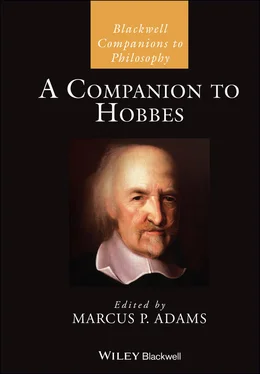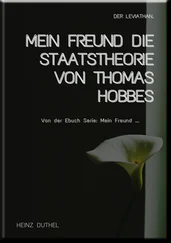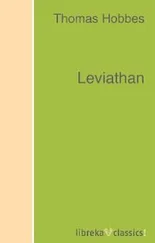1 ...7 8 9 11 12 13 ...48 Michael Byron’s chapter “Hobbes on Submission to God” addresses the nature of what it means for a human to submit to God. To do this, Byron examines Hobbes’s discussion of the “Kingdom of God by Nature” in Leviathan 31, understanding Hobbes as committed to a primary state of nature, which is inhabited by atheists, and a secondary state of nature, which is inhabited by subjects of God’s natural kingdom. To refine these notions, Byron differentiates subjects of this kingdom not only from atheists but also from non-human animals and deists. Reconstructing Hobbes’s account, Byron argues that humans are members of the natural kingdom of God if and only if they acknowledge God’s providential involvement in the world. Atheists are excluded because they deny God’s existence and deists because, while they believe that God exists, they deny God’s providence. Byron furthermore argues that according to Hobbes the act of acknowledgement, unlike that of belief, is voluntary.
Hobbes’s extended treatments of topics related to ecclesiology and theology in Leviathan Parts III and IV set that work apart from Hobbes’s prior works in civil philosophy. Indeed, it is striking that the third part of Leviathan (“On the Christian Commonwealth”) is the longest part of that work. Jeffrey Collins’s chapter “Hobbes and the Christian Commonwealth” examines Hobbes’s usage of the phrase “Christian Commonwealth” by first looking to occurrences of that phrase and related phrases by authors preceding Hobbes and then by showing the different purposes for which Hobbes used the phrase, from his ecumenical use in Elements of Law to uses in Leviathan that are informed by worries about the power of clerics. In the latter, Collins shows how Hobbes first openly rejects Catholic notions of a single Christian commonwealth under Rome and insists, against the views of Bellarmine, that sovereignty lies only in a state and that a sovereign need only endorse minimal theological claims.
The extent to which Hobbes’s sovereign could countenance religious toleration is the focus of Johann Sommerville’s chapter “Hobbes and Toleration.” Sommerville discusses the context in which Hobbes’s concerns related to religious belief and practice emerged and shows that Hobbes viewed toleration of non-Christians as compatible with natural law. Hobbes held that the sovereign should have absolute power and could prohibit religious activities that the sovereign viewed as a threat to the security of the state. Although no religious group would receive a permanent right to toleration according to Hobbes’s model of the state, since circumstances may change and warrant different laws concerning public behavior, nevertheless a range of religious actions and organizations that posed no threat and did not break the law would be permitted.
The amount of space Hobbes devotes to the topic “Of Power Ecclesiastical” in Leviathan 42, as well as his detailed focus upon Cardinal Bellarmine’s arguments, may seem initially puzzling. Franck Lessay’s chapter “Hobbes, Rome’s Enemy” traces this in-depth attack on Bellarmine to broader concerns of Hobbes’s with Roman theology and to his views related to political power. In particular, Lessay highlights Hobbes’s attack on the notion of the “indirect power,” which Bellarmine claimed Rome possessed, showing that for Hobbes this notion was merely a cover for what was in fact direct power. In other words, although advocates of the notion of “indirect power” relied upon a distinction between temporal and spiritual power, Hobbes argues that ultimately it reduced to Rome asserting direct power when it claimed doing so was necessary; it amounted to Rome having the ability to “depose Princes and States” if deemed necessary “for the Salvation of Soules” (Hobbes 2012; 1651, 910). Lessay shows how Hobbes’s renouncement of this notion, along with the location of power within civil sovereigns alone, led to the rejection of his views by Anglican contemporaries and later Catholic thinkers alike.
In the chapter “Hobbes and the Papal Monarchy,” Patricia Springborg argues that the papal monarchy served as the model for the Leviathan in Hobbes’s Leviathan but also was the subject of Part IV of the Leviathan (“Of the Kingdome of Darknesse”). Springborg’s chapter links Hobbes’s Leviathan with his later works, in particular the Latin poem Historia Ecclesiastica , and details Hobbes’s criticisms of the papacy by showing his analysis focused on three papal strategies: first, papal claims to imperial power by means of a transmission of power from Rome; second, co-opting of Roman law as canon law; and third, the creation of an ecclesiastical system of offices paralleling the administrative offices of the old Roman Empire. Tracing the decline of the papal monarchy not only to its overreach but also to the limits of its philosophy of mind, Springborg shows Hobbes’s indebtedness to the canon law tradition alongside his criticisms, in particular related to Hobbes’s understanding of the artificial person of the state.
2.5 Controversies and Reception
The final section of this Companion considers the criticism and reception of Hobbes’s philosophy. Hobbes’s impact was significant, and the range of figures reflected in this section testifies to that fact. 12Although Hobbes’s impact ranged beyond those engaged in philosophy, the focus of the figures considered in these chapters emphasizes engagement with Hobbes’s philosophical ideas.
Descartes’s influence upon seventeenth century physics, and upon mechanical philosophy more generally, is well recognized, with Hobbes’s work in physics receiving comparatively less attention. Edward Slowik argues in “Body and Space in Hobbes and Descartes” that, although there were similarities in each figure’s views, Hobbes’s hypotheses concerning body and space show his differences from Cartesian physics. In particular, Slowik draws attention to differences that stem from Hobbes’s understanding of imaginary space, which follows from his understanding of phantasms, and his account of the material constitution of bodies.
Hobbes never received an invitation to join the Royal Society, as mentioned already, and he and Robert Boyle criticized each other’s work extensively. John Henry’s chapter “Hobbes’s Mechanical Philosophy and Its English Critics” focuses on Hobbes’s natural philosophy by considering how it was attacked by two English critics: Robert Boyle and Henry More. Boyle’s aim was to develop an acausal experimental method against Hobbes’s speculative philosophy. Doing so, Henry shows, aided Boyle’s goal of showing that God must play an active role in the world. More sought to dismiss Hobbes’s monistic materialism in favor of a dualism of body and immaterial spirit. Henry suggests that although these critics, and others, wanted to distance themselves from Hobbist ideas, there are similarities between Hobbes’s corporeal God and Henry More’s concept of an immaterial, three-dimensionally extended God.
Stewart Duncan’s chapter “Cudworth as a Critic of Hobbes” looks to Ralph Cudworth’s criticisms of Hobbes that relate to atheism and to whether morality is eternal and immutable. Cudworth worries about atheism in his work The True Intellectual System of the Universe (1678), and he attacks various versions, singling out Hobbes as a point of focus. Duncan examines Cudworth’s criticisms of the claim that finite beings possess no idea of God, and Cudworth’s accusation that from that claim it would follow that God does not exist. Cudworth responds to this claim that humans possess no idea of God and to what he understands as the arguments in favor of that view. Duncan also discusses Cudworth’s critique of Hobbes in Treatise on Eternal and Immutable Morality (1996) and shows Cudworth’s claim, against his understanding of Hobbes, that which is good is not made so by human decision.
Читать дальше












